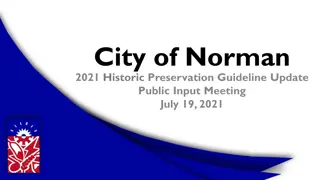Discovering Amman: A Historic City of Jordan
Explore the rich history and vibrant culture of Amman, the capital city of Jordan. Founded in 7000 BC, Amman boasts ancient settlements, Roman fortresses, and a unique layout on seven hills. Discover the diverse neighborhoods, historical landmarks, and educational institutions that make Amman a must-visit destination in the Middle East.
Download Presentation

Please find below an Image/Link to download the presentation.
The content on the website is provided AS IS for your information and personal use only. It may not be sold, licensed, or shared on other websites without obtaining consent from the author. Download presentation by click this link. If you encounter any issues during the download, it is possible that the publisher has removed the file from their server.
E N D
Presentation Transcript
TURZM FAKLTES TUR ZM REHBERL TRH115 TEMEL NG L ZCE r. G r. Ya ar G LTEK N
Amman is the capital and largest city of Jordan and the cultural, political and commercial center. Amman is one of the oldest cities in the world.
Amman was founded in 7000 BC. The first signs of human settlement in the city date back to the Chalcolithic Age (4000-3000 BC).
Amman is located 35 km east of the Dead Sea, 110 km east of the Mediterranean Sea and 65 km east of Jerusalem. The city is located on seven hills, representing the seven-pointed star on the Jordanian flag. Amman is similar to the Mediterranean climate, but still has a different climate. The fact that it is 773 m above sea level affects this. Dense fog is often seen in the city.
Amman is sharply divided into two. The eastern part of the city is a traditional Islamic city and many Palestinian refugees live in shelters on the outskirts. The western part is surrounded by greenery with cafes and art galleries. The Royal Palace is located in the eastern part and the Parliament is in the western part. The most important historical monument of the city is the Roman fortress. There is an ancient theater inside the castle.
There are 14 universities in the city which is an important industrial center. The University of Jordan is the largest university in Amman. Amman ranks 8th among the most visited cities for business travelers and tourists in the Middle East and Africa, and 9th among the cities where international visitors spend the most money.
JABAL AMMAN Jabal Amman neighborhood is one of the seven hills that originally made up Amman, Jordan. Today, Jabal Amman is near the downtown area.
Location Traditionally, the 1st Circle marks the start of Jabal Amman and King Talal Street on the valley floor marks the end of it. 9th Sha'ban Street divides Jabal Amman from Jabal al-Weibdeh in the north. Mango Street runs north-south across the slope. Rainbow Street serves as the main access up and down the mountain to the 1st circle. Jabal Al-Akhddar is on the opposite side of the valley from Jabal Amman.
JABAL AL QALAA The Amman Citadel is a historical site at the center of downtown Amman, the capital of Jordan. The L- shaped hill is one of the seven hills that originally made up Amman.
TOURSM Starting in 1995-6, the Ministry of Tourism and Antiquities of Jordan in partnership with USAID began a project to conserve and restore this site to benefit tourists and the local community. The Amman Citadel is also the site of Jordan Archaeological Museum, which is home to a collection of artifacts from the Citadel and other Jordanian historic sites.
JABAL AL WE BDEH The Jabal al-Weibdeh neighborhood is a bohemian, hipster area found in one of the oldest neighborhoods in Amman. It is filled with a variety of quaint cafes, painted murals, little shops and has quickly become a must-see part of town for both locals and tourists. Jabal al-Weibdeh is a thriving artist haven with rich historical roots, with one foot in the past and the other in the future.
LOCATION Geographically speaking, Jabal al-Weibdeh is found between two important and contrasting areas of the city which contribute to the charm and uniqueness of the area. On one side there is Jabal Amman where you will find many historic sites and buildings along with a variety of art galleries. On the other side, there is downtown Amman, also known as the Balad which is the oldest part of the capital, one that dates back as far as the Neolithic period. From the Amman Citadel, it about an 8-minute drive or 20minutes walk to the neighborhood.
JABAL AKHDAR The Jebel Akhdaris part of Al Hajar Mountains range in Ad Dakhiliyah Governorate of Oman. It extends about 300km northwest to southeast, between 80 161 km inland from the coast of the Gulf of Oman.
NEBO MOUNTA N Nebo Mountain is a mountain located in the Madaba province of Jordan. The height above sea level is about 817 moles, the highest point of the Avarim Mountains to which it is part.
ROYAL AUTOMOBILE MUSEUM Located next to the Al Hussein Public Parks, the museum was established in 2003 upon King Abdullah's wishes. The museum showcases a rare collection of Jordan's vehicles ranging from Hussein bin Ali's cars that came to Amman in 1916 to modern sports cars. The museum has the rover used in filming of Hollywood's movie The Martian, which used Jordan's UNESCO world heritage site Wadi Rum as the backdrop for the Martian scenes. The rover was gifted to Jordan in return for the hospitality with which Jordan received the movie cast and crew.
JORDAN ARCHAEOLOGICAL MUSEUM The Jordan Archaeological Museum is located in the Amman Citadel of Amman, Jordan. Built in 1951, it presents artifacts from archaeological sites in Jordan, dating from prehistoric times to the 15th century. The collections are arranged in chronological order and include items of everyday life such as flint, glass, metal and pottery objects, as well as more artistic items such as jewelry and statues. The museum also includes a coin collection.
REFERENCES https://www.wikizeroo.org/index.php?q=aHR0cHM6Ly90ci53aWtpcGVkaWE ub3JnL3dpa2kvQW1tYW4 https://touristjordan.com/jabal-al-weibdeh-neighborhood/
























